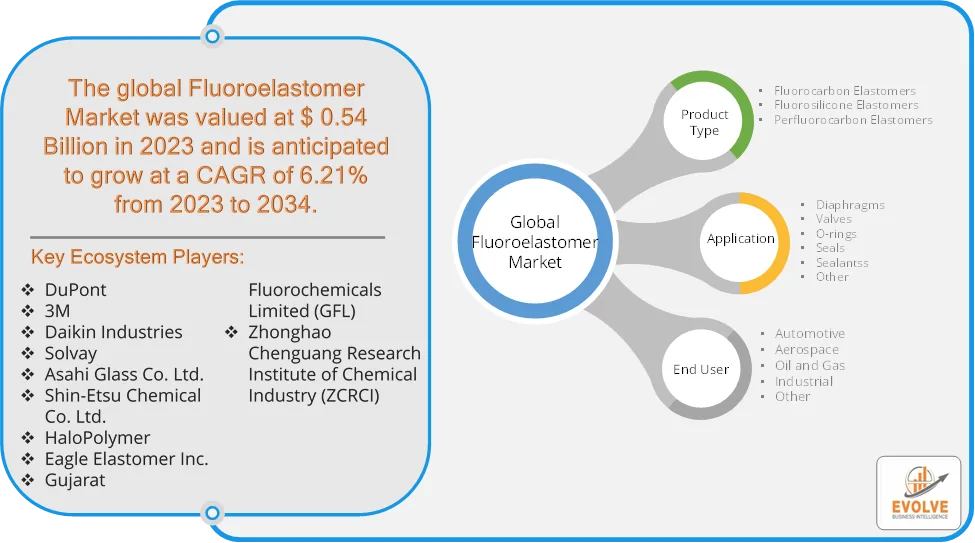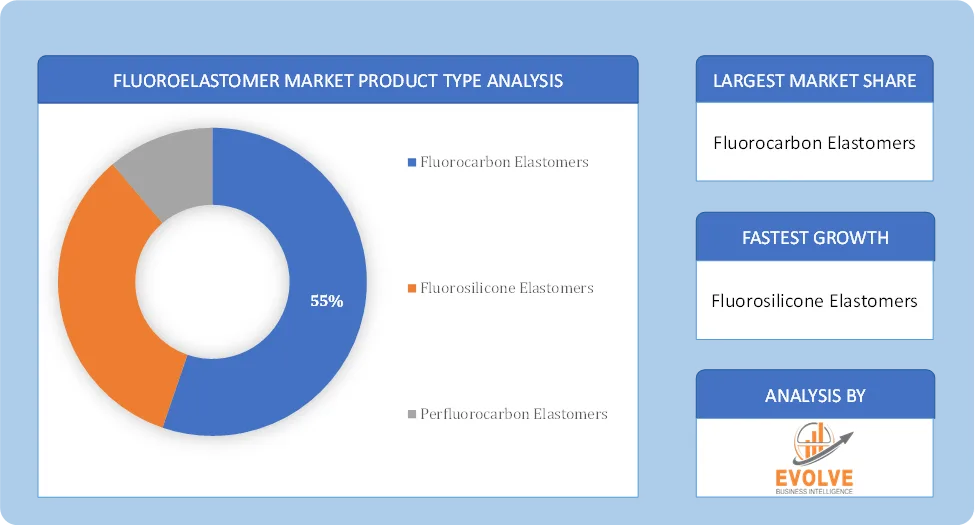Fluoroelastomer Market Overview
The Fluoroelastomer Market size accounted for USD 0.54 Billion in 2023 and is estimated to account for 0.95 Billion in 2024. The Market is expected to reach USD 2.14 Billion by 2034 growing at a compound annual growth rate (CAGR) of 6.21% from 2024 to 2034. The Fluoroelastomer Market is driven by the increasing demand for high-performance elastomers in industries such as automotive, aerospace, chemical processing, and electronics. Fluoroelastomers are synthetic rubber materials known for their excellent resistance to heat, chemicals, fuels, and oils, making them ideal for applications requiring durability and reliability. Fluoroelastomers are widely used in automotive seals, gaskets, and O-rings due to their high thermal and chemical resistance.
The fluoroelastomer market is poised for continued growth, driven by the increasing demand for high-performance materials in critical applications across various industries.
Global Fluoroelastomer Market Synopsis
 Fluoroelastomer Market Dynamics
Fluoroelastomer Market Dynamics
The major factors that have impacted the growth of Fluoroelastomer Market are as follows:
Drivers:
Ø Growing Automotive Industry
Fluoroelastomers are widely used in seals, gaskets, O-rings, and fuel system components due to their resistance to extreme temperatures and aggressive fluids. The shift towards fuel-efficient and hybrid vehicles is increasing the demand for high-performance elastomers. The semiconductor industry requires low-contamination, high-purity elastomers for use in chip manufacturing, plasma etching, and cleanroom applications. Fluoroelastomers provide chemical resistance and thermal stability, essential for semiconductor fabrication and the rise of 5G, IoT, and AI-driven devices is increasing the need for high-performance elastomer components in electronic manufacturing.
Restraint:
- High Production Costs & Expensive Raw Materials
Fluoroelastomers are more expensive than conventional elastomers (e.g., nitrile rubber, silicone rubber) due to their complex manufacturing process and costly raw materials. The cost of fluorinated monomers (such as vinylidene fluoride and tetrafluoroethylene) is high, making fluoroelastomers less accessible for cost-sensitive applications. Price volatility of raw materials due to supply chain disruptions affects market growth.
Opportunity:
⮚ Rising Demand in Electric Vehicles (EVs) & Battery Applications
EVs require high-performance elastomers for battery sealing, cooling systems, and electrical insulation. Fluoroelastomers provide chemical resistance and thermal stability, crucial for lithium-ion battery packs and EV powertrains. Growing EV adoption, driven by government incentives and emission regulations, is fueling demand. Rising demand for biocompatible and sterilization-resistant materials in medical devices. Fluoroelastomers are used in pharmaceutical processing, medical pumps, and diagnostic equipment. Growth in drug manufacturing, biotechnology, and healthcare infrastructure boosts demand.
Fluoroelastomer Market Segment Overview
Based on Product Type, the market is segmented based on Fluorocarbon Elastomers, Fluorosilicone Elastomers, Perfluorocarbon Elastomers. The Fluorocarbon Elastomers segment dominant the Fluoroelastomer market due to its excellent resistance to a wide range of chemicals, oils, and high temperatures, making it a preferred choice in critical applications across industries such as automotive, aerospace, and oil and gas.
By Application
Based on Application, the market segment has been divided into Diaphragms, Valves, O-rings, Seals, and Sealants, Other. The Diaphragms segment dominant the Elbow Sleeve market due to the diaphragm’s crucial role in providing effective support, compression, and flexibility for elbow joints, catering to diverse applications in sports, rehabilitation, and medical scenarios.
By End User
Based on End User, the market segment has been divided into the Automotive, Aerospace, Oil and Gas, Industrial, Other. The Automotive segment is the largest segment of the market. The increased demand for fuel-efficient and lightweight vehicles is driving the growth of the automotive segment.
Global Fluoroelastomer Market Regional Analysis
Based on region, the global Fluoroelastomer Market has been divided into North America, Europe, Asia-Pacific, the Middle East & Africa, and Latin America. North America is projected to dominate the use of the Fluoroelastomer Market followed by the Asia-Pacific and Europe regions.

North America Global Fluoroelastomer Market
North America holds a dominant position in the Fluoroelastomer Market. The North American market is driven by demand from the automotive, aerospace, and semiconductor industries. The United States dominates the market due to the presence of major aerospace and automotive manufacturers. High adoption of fluoroelastomers in aircraft engine seals and fuel systems and the growth of the semiconductor industry in the U.S. boosts applications in electronics manufacturing.
Asia-Pacific Global Fluoroelastomer Market
The Asia-Pacific region has indeed emerged as the fastest-growing market for the Fluoroelastomer Market industry. Asia-Pacific dominates the market in terms of growth due to expanding automotive, electronics, and chemical industries. China, Japan, South Korea, and India are key contributors. Booming automotive industry in China and India, increasing demand for fluoroelastomers in engine components, fuel hoses, and gaskets and expanding chemical processing and oil & gas industries in China drive demand for durable elastomers.
Competitive Landscape
The global Fluoroelastomer Market is highly competitive, with numerous players offering a wide range of software solutions. The competitive landscape is characterized by the presence of established companies, as well as emerging startups and niche players. To increase their market position and attract a wide consumer base, the businesses are employing various strategies, such as product launches, and strategic alliances.
Prominent Players:
- DuPont
- 3M
- Daikin Industries
- Solvay
- Asahi Glass Co. Ltd.
- Shin-Etsu Chemical Co. Ltd.
- HaloPolymer
- Eagle Elastomer Inc.
- Gujarat Fluorochemicals Limited (GFL)
- Zhonghao Chenguang Research Institute of Chemical Industry (ZCRCI).
Scope of the Report
Global Fluoroelastomer Market, by Product Type
- Fluorocarbon Elastomers
- Fluorosilicone Elastomers
- Perfluorocarbon Elastomers
Global Fluoroelastomer Market, by Application
- Diaphragms
- Valves
- O-rings
- Seals
- Sealantss
- Other
Global Fluoroelastomer Market, by End User
- Automotive
- Aerospace
- Oil and Gas
- Industrial
- Other
Global Fluoroelastomer Market, by Region
- North America
- US
- Canada
- Mexico
- Europe
- UK
- Germany
- France
- Italy
- Spain
- Benelux
- Nordic
- Rest of Europe
- Asia Pacific
- China
- Japan
- South Korea
- Indonesia
- Austalia
- Malaysia
- India
- Rest of Asia Pacific
- South America
- Brazil
- Argentina
- Rest of SouthAmerica
- Middle East &Africa
- Saudi Arabia
- UAE
- Egypt
- SouthAfrica
- Rest of Middle East & Africa
| Parameters | Indicators |
|---|---|
| Market Size | 2033: USD 2.14 Billion |
| CAGR (2023-2033) | 6.21% |
| Base year | 2022 |
| Forecast Period | 2023-2033 |
| Historical Data | 2021 (2017 to 2020 On Demand) |
| Report Coverage | Revenue Forecast, Competitive Landscape, Growth Factors, and Trends |
| Key Segmentations | Product Type, Application, End User |
| Geographies Covered | North America, Europe, Asia-Pacific, South America, Middle East, Africa |
| Key Vendors | DuPont, 3M, Daikin Industries, Solvay, Asahi Glass Co. Ltd., Shin-Etsu Chemical Co. Ltd., HaloPolymer, Eagle Elastomer Inc., Gujarat Fluorochemicals Limited (GFL) and Zhonghao Chenguang Research Institute of Chemical Industry (ZCRCI). |
| Key Market Opportunities | · Rising Demand in Electric Vehicles (EVs) & Battery Applications · Increasing Use in the Medical & Healthcare Sector |
| Key Market Drivers | · Automotive Industry · Rapid Growth in Semiconductor & Electronics Industrys |
REPORT CONTENT BRIEF:
- High-level analysis of the current and future Fluoroelastomer Market trends and opportunities
- Detailed analysis of current market drivers, restraining factors, and opportunities in the future
- Fluoroelastomer Market historical market size for the year 2021, and forecast from 2023 to 2033
- Fluoroelastomer Market share analysis at each product level
- Competitor analysis with detailed insight into its product segment, Government & Defense strength, and strategies adopted.
- Identifies key strategies adopted including product launches and developments, mergers and acquisitions, joint ventures, collaborations, and partnerships as well as funding taken and investment done, among others.
- To identify and understand the various factors involved in the global Fluoroelastomer Market affected by the pandemic
- To provide a detailed insight into the major companies operating in the market. The profiling will include the Government & Defense health of the company’s past 2-3 years with segmental and regional revenue breakup, product offering, recent developments, SWOT analysis, and key strategies.







